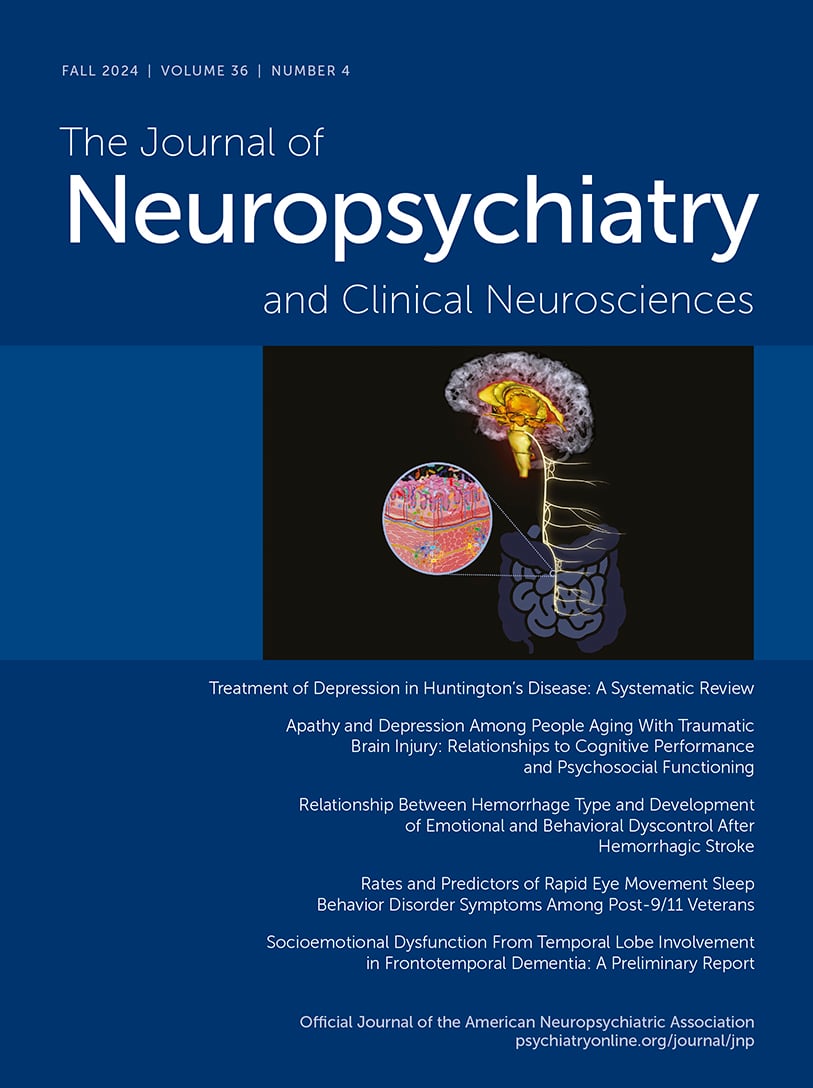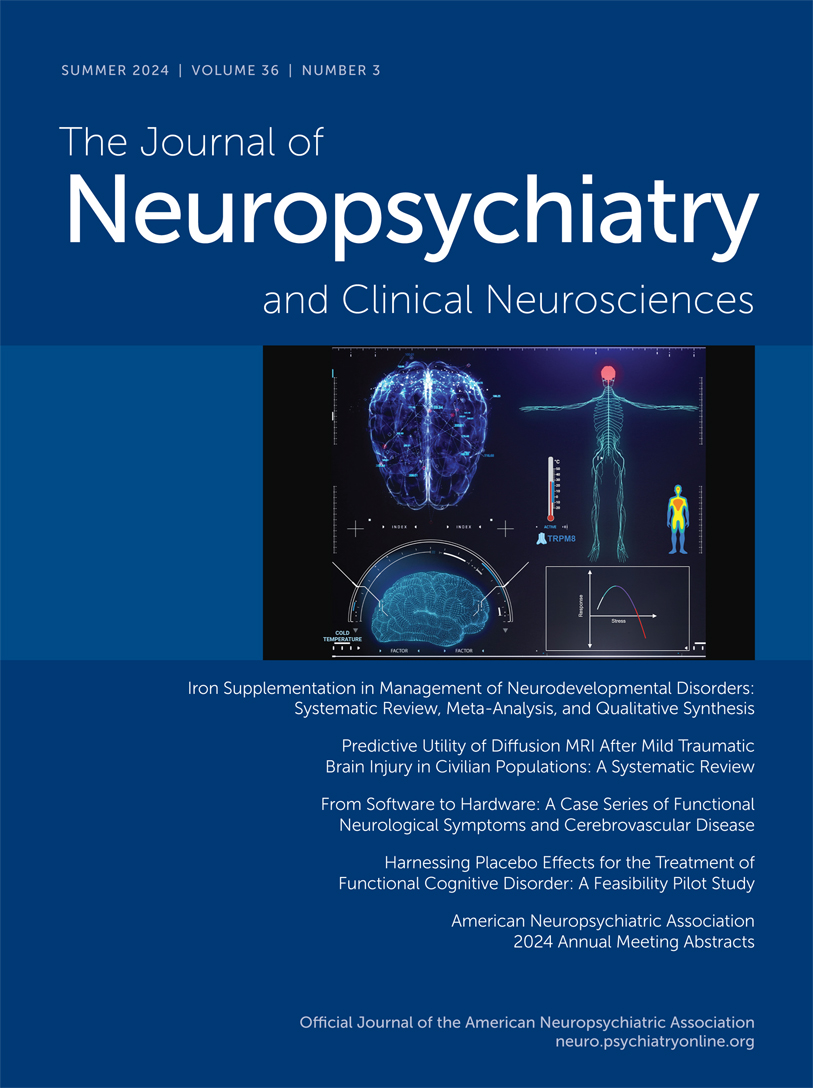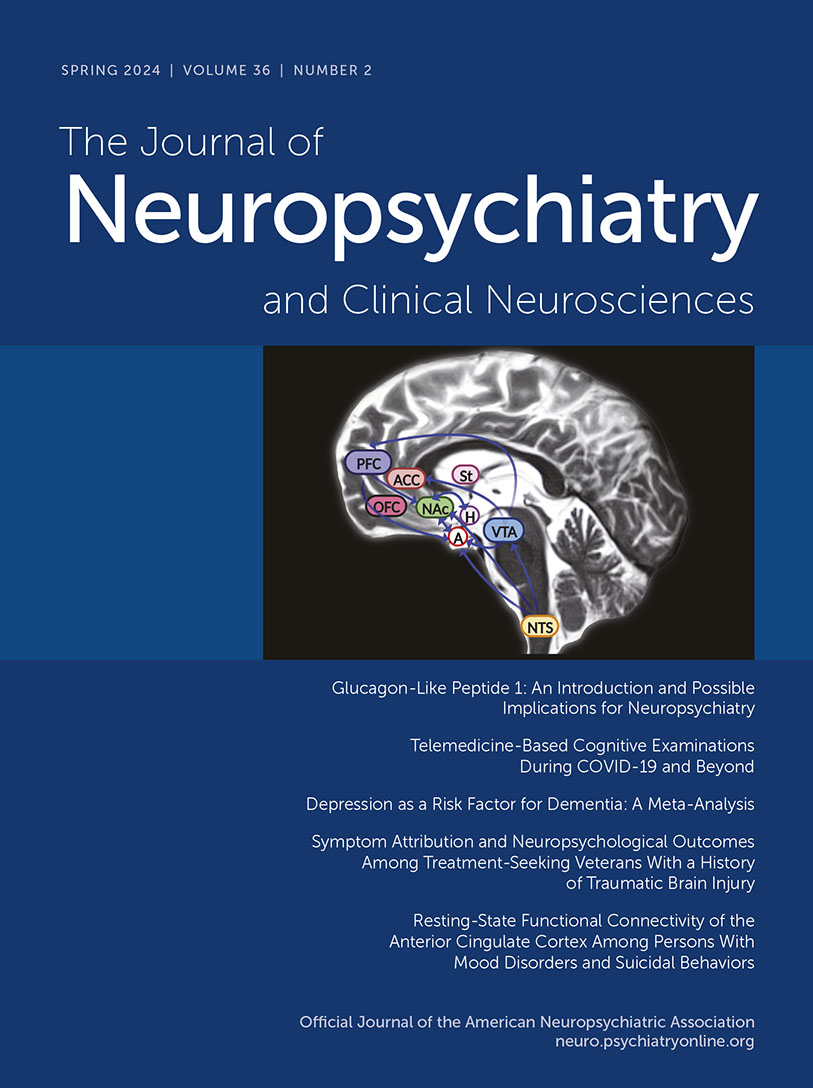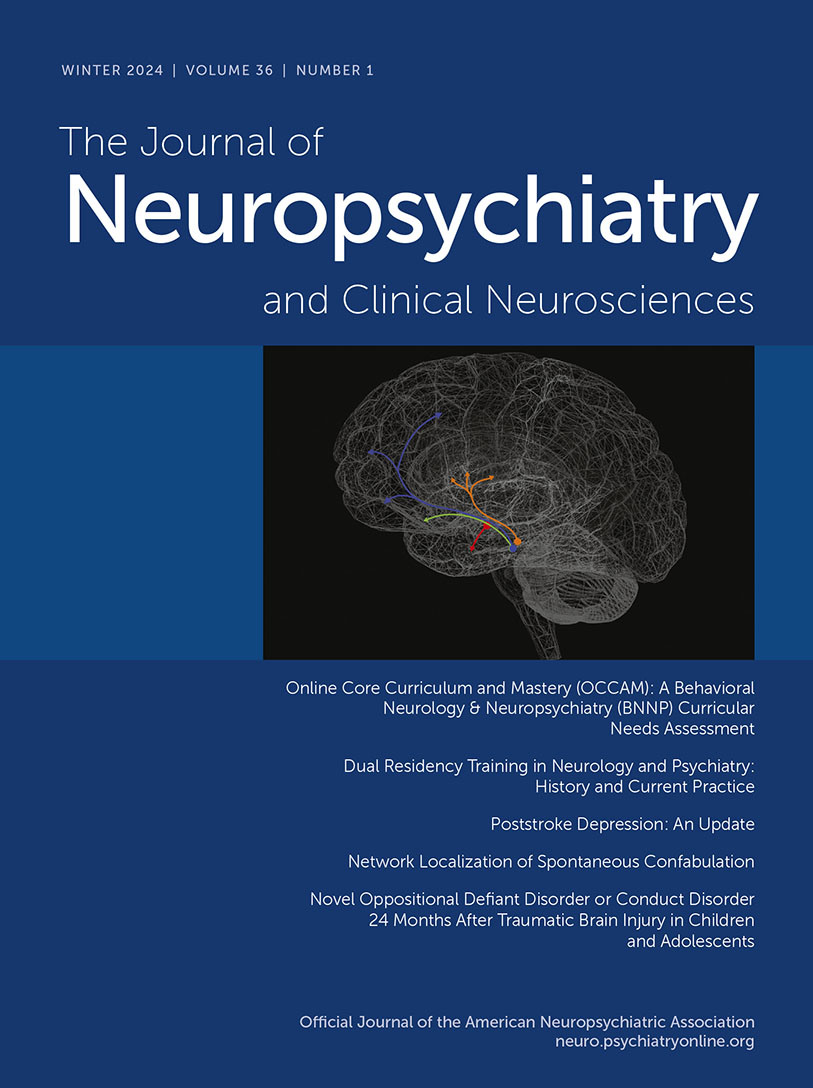The Journal of Neuropsychiatry and Clinical Neurosciences
- Volume 24
- Number 2
- April 2012
Letters
Departments
Windows to the Brain
Publication date: 01 April 2012
Pages118–124This issue's Windows to the Brain series describes the ways in which the adult brain, once thought to be “fixed and stable,” adapts to and recovers from various “brain-altering” conditions. The processes of neurogenesis, migration, and pruning do, in fact,...
https://doi.org/10.1176/appi.neuropsych.12050109Special Articles
Publication date: 01 April 2012
Pages125–140Few methods are available to explore the impact of neurocognition in schizophrenia on behaviors performed in usual contexts. The authors developed a video ethnography approach to examine the relationship between naturalistic behaviors and research ...
https://doi.org/10.1176/appi.neuropsych.11080201Publication date: 01 April 2012
Pages141–151The authors present a possible neurological explanation of the syndrome of conversion disorder, a syndrome that has traditionally been at the interface of psychiatry and neurology. There are neural and clinical parallels between “lesional unawareness” ...
https://doi.org/10.1176/appi.neuropsych.11050110Publication date: 01 April 2012
Pages152–164This literature review covers findings, by specific illness condition, on effects and outcome of yoga practice by patients with various degrees of severity and duration of illness; all but one study used randomized, controlled trials. The neurological-...
https://doi.org/10.1176/appi.neuropsych.11040090Regular Articles
Publication date: 01 April 2012
Pages165–175Cognitive and olfactory deficits occur in schizophrenia, but little is known whether sex modifies these deficits. We examined the relationship between olfaction and cognition in 55 schizophrenia patients and 32 healthy controls. Patients and controls ...
https://doi.org/10.1176/appi.neuropsych.11070154Publication date: 01 April 2012
Pages176–182A group of eight patients with severe depression lasting 6 years or longer were treated with anterior capsulotomy and followed prospectively. Stereotactic surgery was used to produce radiofrequency lesions in the anterior limbs of both internal capsules. ...
https://doi.org/10.1176/appi.neuropsych.11080189Publication date: 01 April 2012
Pages183–190HIV-associated neurocognitive disorders (HAND) remain highly prevalent in the era of combination antiretroviral therapies, but there are no validated psychological interventions aimed at improving cognitive outcomes. This study sought to determine the ...
https://doi.org/10.1176/appi.neuropsych.11100301Publication date: 01 April 2012
Pages191–197The serotonergic system is implicated in disordered emotional behavior. Autism is characterized by impaired processing of emotional information. The serotonergic (5-HT) system is also critically involved in brain development, and abnormal brain synthesis ...
https://doi.org/10.1176/appi.neuropsych.11080202Publication date: 01 April 2012
Pages198–207Identification of individuals with catatonic disorder secondary to a general medical condition (CD-GMC) may affect both acute and long-term patient management. The authors performed a 20-year retrospective cohort analysis of all patients meeting DSM-IV-TR ...
https://doi.org/10.1176/appi.neuropsych.11060120Publication date: 01 April 2012
Pages208–214Stereotypies are frequently reported in frontotemporal dementia. Their pathophysiology and optimal treatment are largely unexplored. The author reports seven cases of marked stereotype in patients with probable frontotemporal dementia who were treated ...
https://doi.org/10.1176/appi.neuropsych.11030077Publication date: 01 April 2012
Pages215–222Few tools assessing neurocognitive dysfunction in schizophrenia are able to measure integrated executive functions in the context of the problem-solving demands of a patient’s everyday world. The authors evaluated the BRIEF–A (Behavior Rating Inventory of ...
https://doi.org/10.1176/appi.neuropsych.11060145Publication date: 01 April 2012
Pages223–236The medial forebrain bundle (MFB), a key structure of reward-seeking circuitry, remains inadequately characterized in humans despite its vast importance for emotional processing and development of addictions and depression. Using Diffusion Tensor Imaging ...
https://doi.org/10.1176/appi.neuropsych.11080180Clinical and Research Reports
Publication date: 01 April 2012
Pages237–240The Flexyx Neurotherapy System (FNS), a novel variant of EEG biofeedback, was adapted for intervention with seven treatment-refractory Afghanistan/Iraq war veterans, and brought about significant decreases in bothersome neurobehavioral and posttraumatic ...
https://doi.org/10.1176/appi.neuropsych.11020041Publication date: 01 April 2012
Pages241–246The relationship between psychotic disorders, in particular, schizophrenia, and neurodevelopmental abnormalities has been conceptualized in the latest literature. Dandy-Walker variant, defined by cystic dilatation of the fourth ventricle and hypoplasia of ...
https://doi.org/10.1176/appi.neuropsych.11090207Publication date: 01 April 2012
Pages247–254Anti-NMDAR (N-methyl-d-aspartate receptor) encephalitis is a novel autoimmune and paraneoplastic disease often presenting as acute psychosis. Few studies exist in the psychiatric literature on neuroimmunity and behavioral management. This article reviews ...
https://doi.org/10.1176/appi.neuropsych.11070151Departments
Letters
Past Issues
View Issues Archive
Vol. 36 | No. 4

Vol. 36 | No. 3

Vol. 36 | No. 2
